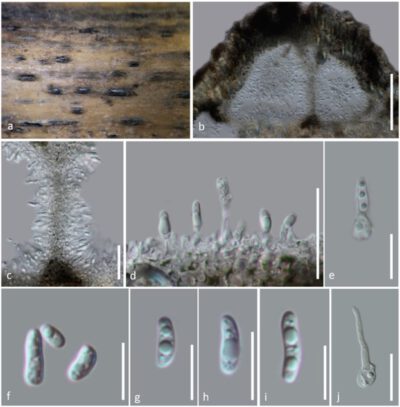Fungalpedia – Note 125 Towyspora
Towyspora Wanasinghe, E.B.G. Jones & K.D. Hyde
Citation when using this entry: Gunarathne et al., in prep – The new genera and higher taxa described in 2016. Mycosphere.
Index Fungorum, Facesoffungi, MycoBank, GenBank, Fig 1.
The monotypic genus Towyspora was introduced by Li et al., (2016) to accommodate Towyspora aestuari based on phylogeny and morphology. The genus name is derived from the river Towy, Wales, in which the specimen was found. Towyspora is classified in Lentitheciaceae, Pleosporales, Dothideomycetes, Ascomycota (Li et al. 2016). Towyspora aestuari is saprobic on Phragmites communis (Poaceae); an aquatic shrub, and has semi-immersed to immersed, stromatic and pycnidial conidiomata. In the phylogenetic analysis based on ITS, SSU, LSU, and Tef sequence data, T. aestuari formed a separate clade from Setoseptoria with high bootstrap support. Towyspora is similar to Setoseptoria in having subcylindrical, hyaline conidiogenous cells and hyaline, smooth-walled, transversely euseptate, subcylindrical conidia with a single large central guttule per cell. However, Towyspora aestuari differs from Setoseptoria phragmitis, the type species of the genus Setoseptoria, which has smaller and aseptate conidia (Quaedvlieg et al. 2013). The sexual morph of the species is not determined.
Type species: Towyspora aestuari Wanasinghe, E.B.G. Jones & K.D. Hyde
Other accepted species: This genus in monotypic.
Figure 1 – Towyspora aestuari (MFLU 15–3543) a Conidiomata on host. b, c Vertical section through conidioma. d, e Conidiogenous cells with conidia. f-i Conidia. j Germinated conidium. Scale bars: b–d = 100 µm, e-i = 10 µm, j = 20 µm. Photo Credits: Dhanushka N. Wanasinghe.
References
Quaedvlieg W, Verkley GJM, Shin HD, Barreto RW et al. 2013 – Sizing up Septoria. Studies in Mycology 75, 307–390.
Entry by
Anujani Gunarathne, The Center of Excellence in Fungal Research, Mae Fah Luang University, Thailand.
(Edited by Chitrabhanu S. Bhunjun & Kevin D. Hyde)
Published online 22 September 2023
